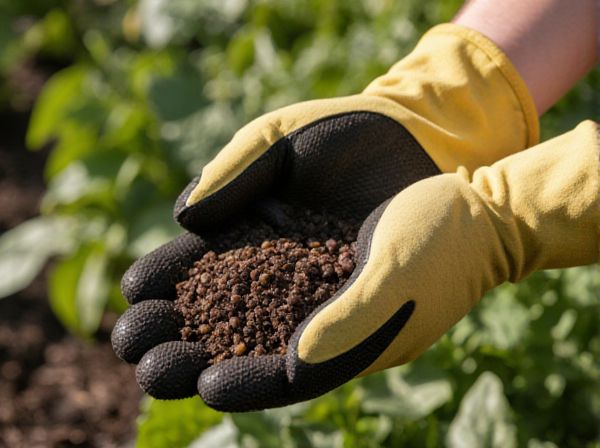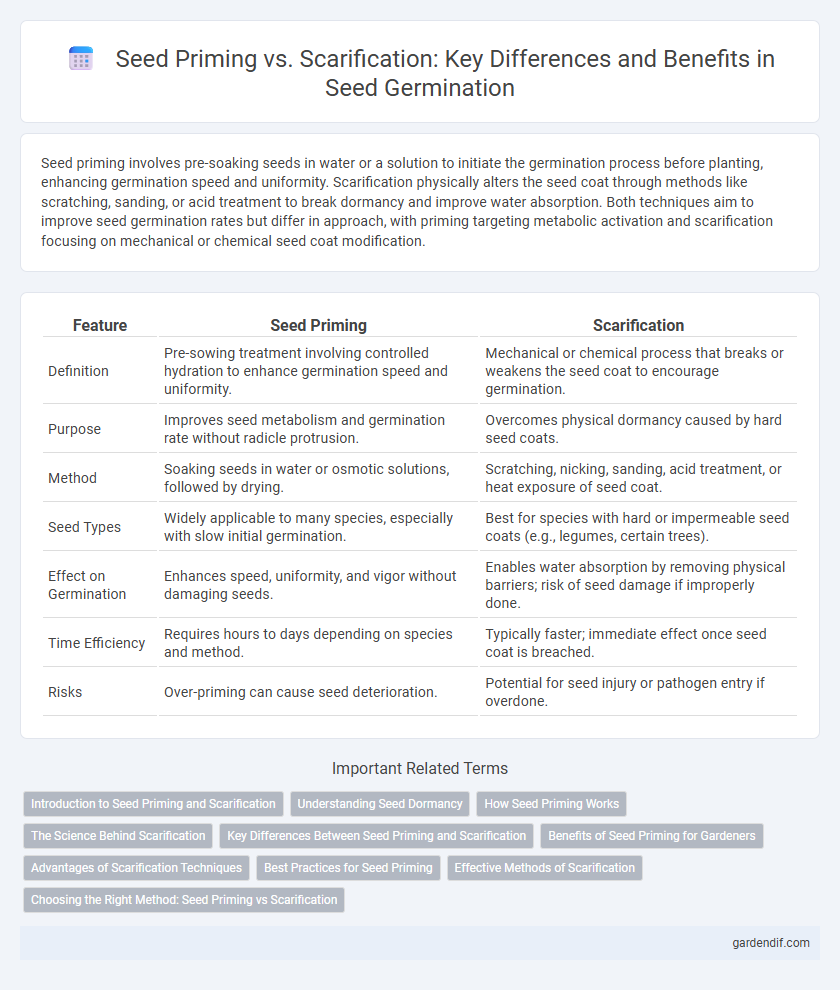
Seed priming vs Scarification Illustration
Seed priming involves pre-soaking seeds in water or a solution to initiate the germination process before planting, enhancing germination speed and uniformity. Scarification physically alters the seed coat through methods like scratching, sanding, or acid treatment to break dormancy and improve water absorption. Both techniques aim to improve seed germination rates but differ in approach, with priming targeting metabolic activation and scarification focusing on mechanical or chemical seed coat modification.
Table of Comparison
| Feature | Seed Priming | Scarification |
|---|---|---|
| Definition | Pre-sowing treatment involving controlled hydration to enhance germination speed and uniformity. | Mechanical or chemical process that breaks or weakens the seed coat to encourage germination. |
| Purpose | Improves seed metabolism and germination rate without radicle protrusion. | Overcomes physical dormancy caused by hard seed coats. |
| Method | Soaking seeds in water or osmotic solutions, followed by drying. | Scratching, nicking, sanding, acid treatment, or heat exposure of seed coat. |
| Seed Types | Widely applicable to many species, especially with slow initial germination. | Best for species with hard or impermeable seed coats (e.g., legumes, certain trees). |
| Effect on Germination | Enhances speed, uniformity, and vigor without damaging seeds. | Enables water absorption by removing physical barriers; risk of seed damage if improperly done. |
| Time Efficiency | Requires hours to days depending on species and method. | Typically faster; immediate effect once seed coat is breached. |
| Risks | Over-priming can cause seed deterioration. | Potential for seed injury or pathogen entry if overdone. |
Introduction to Seed Priming and Scarification
Seed priming enhances germination speed and uniformity by partially hydrating seeds under controlled conditions, activating metabolic processes without allowing radicle emergence. Scarification involves physically or chemically breaking seed coat dormancy to improve water uptake for seeds with hard coats, facilitating faster germination. Both techniques optimize seed performance but target different dormancy mechanisms.
Understanding Seed Dormancy
Seed dormancy is a natural mechanism that prevents germination until conditions are favorable, with seed priming and scarification serving distinct roles in overcoming it. Seed priming involves controlled hydration that initiates metabolic processes without radicle emergence, enhancing germination speed and uniformity. Scarification physically modifies the seed coat, breaking mechanical barriers to water and gas uptake, crucial for hard-coated seeds with impermeable seed coats.
How Seed Priming Works
Seed priming enhances germination by partially hydrating seeds to activate metabolic processes without allowing radicle protrusion. This controlled imbibition initiates enzymatic activities, repair mechanisms, and energy metabolism, leading to faster and more uniform seedling emergence. Unlike scarification, which physically breaks seed coats, priming improves seed performance through physiological conditioning.
The Science Behind Scarification
Scarification enhances seed germination by physically breaking or weakening the seed coat, allowing water and gases to penetrate and activate metabolic processes essential for growth. This process mimics natural wear caused by environmental factors such as abrasion, microbial activity, or passage through an animal's digestive tract, which are critical in overcoming seed dormancy. Scarification techniques vary from mechanical abrasion to chemical treatments, each designed to optimize seed coat permeability and improve uniformity and speed of germination.
Key Differences Between Seed Priming and Scarification
Seed priming enhances germination by partially hydrating seeds to activate metabolic processes without radicle emergence, improving uniformity and speed of sprouting. Scarification physically alters the seed coat through methods like abrasion or acid treatment to break dormancy and allow water uptake. Priming targets internal physiological readiness, while scarification addresses mechanical barriers to germination.
Benefits of Seed Priming for Gardeners
Seed priming enhances germination speed and uniformity, giving gardeners a reliable head start in plant development compared to scarification, which mainly assists in breaking seed dormancy. It improves seedling vigor and stress tolerance by hydrating seeds under controlled conditions, resulting in higher crop yields and healthier plants. This technique also reduces the vulnerability of seeds to fungal infections and environmental stresses during early growth stages, supporting sustainable gardening practices.
Advantages of Scarification Techniques
Scarification techniques significantly enhance seed germination by breaking seed coat dormancy, allowing faster water absorption and oxygen exchange crucial for embryo development. Mechanical scarification improves germination rates in hard-coated seeds such as legumes and eucalyptus, reducing the need for chemical treatments. These methods offer precise control, lower environmental impact, and cost-effectiveness, making them advantageous for large-scale agricultural and reforestation projects.
Best Practices for Seed Priming
Seed priming enhances germination speed and uniformity by partially hydrating seeds under controlled conditions, optimizing enzymatic activity without allowing radicle protrusion. Best practices for seed priming include precise control of water potential, temperature, and duration to prevent seed damage and ensure consistent results across seed batches. Selecting appropriate priming agents such as hydropriming, osmopriming, or biopriming based on seed species and desired stress tolerance maximizes seedling vigor and crop establishment.
Effective Methods of Scarification
Scarification techniques enhance seed germination by breaking seed coat dormancy through mechanical, chemical, or thermal methods that increase water absorption. Mechanical scarification involves physically nicking or sanding the seed coat, while chemical scarification uses acids to weaken tough outer layers. Thermal scarification applies controlled heat to mimic natural processes like fire, making these methods highly effective for hard-coated seeds such as legumes and certain tree species.
Choosing the Right Method: Seed Priming vs Scarification
Choosing between seed priming and scarification depends on the seed type and desired germination speed; seed priming enhances hydration and metabolic activity for uniform sprouting, ideal for small or hard-coated seeds. Scarification physically breaks or softens hard seed coats, enabling water absorption and gas exchange, which is crucial for seeds with impermeable shells like legumes and certain trees. Understanding seed physiology and environmental conditions ensures the selection of the most effective pre-sowing treatment for optimal crop yield.
Seed priming vs Scarification Infographic

 gardendif.com
gardendif.com